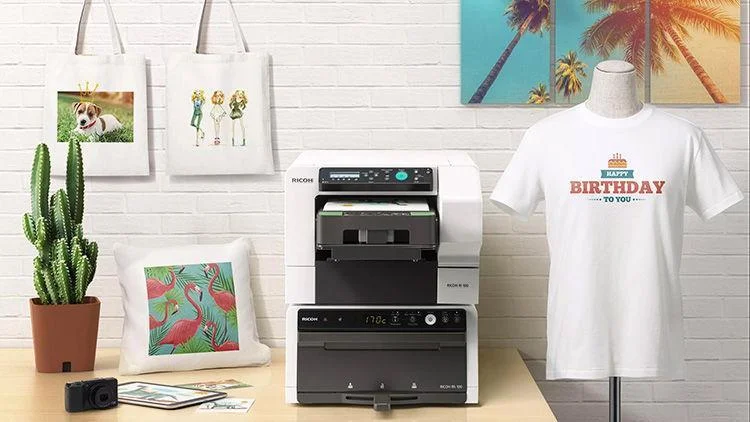What is a digital transfer printer?
Digital transfer printers, which are also known as heat transfer printers in the T-shirt printing industry, are printers that allow you to print designs onto heat transfer paper. This allows you to transfer your designs to the surface of T-shirts, mugs, tote bags, aprons, and more!
A digital transfer is worthwhile if you’re starting a custom T-shirt printing business, or if you just want to take your digital designs and affix them to various garments and objects. However, you may be wondering what a digital transfer printer is, or how they differ from regular printers.
We’re here to help answer these questions, as well as anything else you might want to know about digital transfer printers!
So, What is a Digital Transfer Printer?

Essentially, a digital transfer printer can accommodate heat transfer paper. This specialized paper is designed with a layer of wax that allows the ink to transfer onto another surface when it’s heated to a specific temperature.
While you can heat the paper up and transfer a design or printed text with a typical household iron, it will work better if you can use a heat press, as they’ll generate the ideal temperature and pressure required to cleanly transfer the ink onto your desired surface.
Is There a Difference Between a Laser and an Inkjet Digital Transfer Printer?

While there are certainly differences between how the two types of printers operate, both can accommodate heat transfer paper, so they can both be considered digital transfer printers.
With that being said, inkjet printers and laser printers use different types of heat transfer paper, so make sure you buy the appropriate type of heat transfer paper for your specific printer.
Using an Inkjet Printer for Heat Transfer Printing
Inkjet printers cannot print white ink, so any designs that incorporate white should be pressed onto a white surface.
For example, if you were planning to print a design that featured white elements on a T-shirt, you’d want to choose a white, or very light-colored, fabric. You’d then print the white areas of your design as empty space and allow the color of the fabric to act as the white in your design.
Inkjet printers also take longer to print than laser printers, which can be an issue if you’re planning to run a printing business. If you have a significant number of projects on the go, an inkjet printer could potentially slow you down and impact your ability to fulfill orders on time.
Using a Laser Printer for Heat Transfer Printing
While laser printers are fast and offer plenty of advantages, they tend to produce inferior results when working with heat transfer paper.
In many cases, the designs do not look quite as crisp, and they can even come out a little bit distorted, which doesn’t work well for complex designs.
Are Digital Transfer Printers Expensive?

While high-quality printers that are capable of printing high-resolution heat transfers used to be incredibly expensive, you can now buy them for around $350. Given that this device can greatly improve the overall quality of your products, it’s worth spending extra money on a good one.
If you’re planning to run your own business, remember that your digital transfer printer should be seen as an investment and a major start-up expense. Don’t try to save money upfront by choosing a low-quality option that you’ll need to replace in the future.
What Should You Look for in a Digital Transfer Printer?

While you have many options when it comes to choosing a digital transfer printer, there are a few features you should keep an eye out for.
By taking the following into consideration, you’ll be able to find a high-quality printer that will allow you to heat transfer your designs with outstanding results:
Print Speed
As mentioned previously, print speed can be an important factor if you’re planning to start a printing business. Your progress can be stalled and large orders can take far longer to complete if you’re held back by a slow printer.
With that being said, if you’re simply heat transferring as a hobby, the print speed may be less important to you.
WARNING: You should also make sure that you aren’t choosing an inferior printer just because it’s fast. You never want to sacrifice quality for speed.
Continuous Ink Supply System (CISS) Compatibility
If you’re operating a printing business, installing a Continuous Ink Supply System could be a worthwhile investment.
While they’re typically sold separately, these systems ensure that your printer is fed ink from a large reservoir, rather than simply relying on the small ink cartridges most personal and office printers use.
A CISS can save you time because you’ll no longer have to worry about changing ink cartridges throughout the day.
REMEMBER: Given that heat transfer paper is expensive, choosing a machine that’s compatible with a Continuous Ink Supply System is important.
Color Options
If you’re planning on printing full-color designs, you’ll want to choose a printer that’s capable of printing a wide range of colors. For example, inkjet printers typically produce more vivid colors.
Size of Heat Transfer Paper the Printer Can Accommodate
Any printer will list the different types and sizes of paper it can accommodate. If you’re looking to heat transfer large designs, you’ll need a printer that can handle those larger sheets of transfer paper.
If you’re only working with small designs, you could be okay with a standard printer that only accommodates A4-sized paper; however, for much larger images and text, you may want a larger printer that can handle A3-, A2-, A1- and even A0-sized sheets.
Versatility
If you have a limited budget, the versatility of the printer can make it a more worthwhile option. Many come with a built-in scanner, which can be useful for scanning your drawings, so you can turn them into digital images that you can print.
TIP: If you’re starting a new business, it can also be worthwhile to have a printer that can double as a fast office printer, as well as a high-quality heat transfer printer. Why not have a single printer that can handle every task?
Now that you know the answer to the question, “what is a digital transfer printer?”, you can get started on your designs!